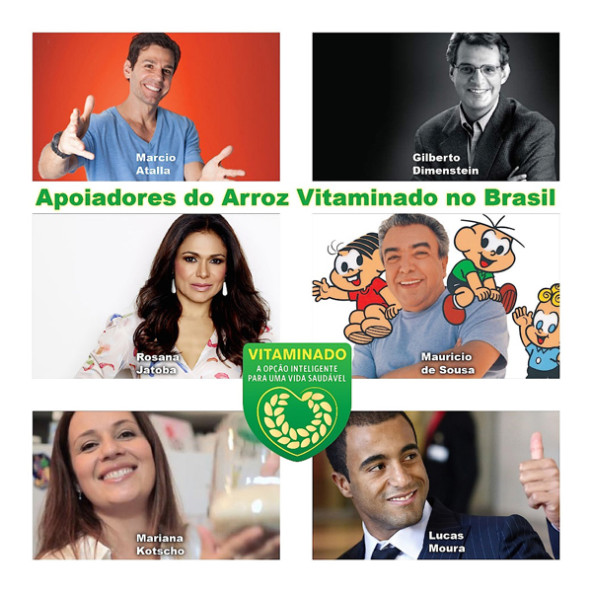Brazil is the seventh-richest country in the world, with an economy worth more than $2 trillion. Despite this, the country struggles with a challenge common to many developing economies: malnutrition. Some 18 percent of Brazil’s children under age five suffer from vitamin A deficiency, which can lead to blindness, and about 40 percent are iron-deficient and anemic, which can impact cognitive development and cause extreme fatigue. Meanwhile, 40 percent of lower-income women don’t get enough of the essential nutrient thiamine, which supports the nervous system and metabolism. Inadequate levels of these and other micronutrients have major long-term deleterious effects on overall health.
These statistics, while specific to Brazil, are part of a bigger global problem. “Hidden hunger” affects some two billion people worldwide—people who may not be underweight or exhibit any obvious symptoms of malnutrition, but who still suffer health consequences from not getting enough of the micronutrients they need in their diets.
Food fortification is a powerful way of addressing this challenge—so powerful that it has the consistent support of the UN Food and Agriculture Organization and the World Health Organization, and is ranked as a top-three international development priority by the Copenhagen Consensus Centre.
As one of the most common staple foods in the world, rice holds particular promise as a fortified food, with global per-capita consumption at some 300 grams a day and rising. In Brazil, millers play a central role in distributing and marketing branded rice products to retailers and consumers. But until recently, there were no direct partnerships with rice millers to penetrate commercial markets with fortified rice and create a replicable model for the large-scale commercial fortification of rice.
Magic Rice
Are you enjoying this article? Read more like this, plus SSIR's full archive of content, when you subscribe.
Nicknamed “magic rice” by Mauricio de Sousa (creator of Mônica, a beloved national cartoon character and UNICEF’s only animated ambassador), arroz vitaminado (meaning “vitamin rice”) is fortified with vitamin B1, folic acid, iron, and zinc. The result of more than 15 years of work, arroz vitaminado uses technology developed by PATH, funded by the Bill & Melinda Gates Foundation and brought to market in partnership with the Global Alliance for Improved Nutrition (GAIN).
Instead of pursuing a more-conventional development model, the partners instead chose to transfer the technology rights to leading rice miller Urbano and other interested private companies in Brazil. Empowering local industry and adding credibility to the fortified products, this approach was also an important test of the public health impact that a purely market-based approach to fortification could have.
Introduced to consumers in early 2013, by October 2014 more than two million consumers had tried the new products, with almost a third turning into repeat customers and most from the target social segments—lower-income families. Despite the slightly higher price of the fortified rice, some 89 percent of current consumers plan to continue buying the product, and almost half have recommended the product to others.
So just how did we manage to achieve so much in so little time?
The Power of Social Marketing
Like many other countries, Brazilians can be resistant to trying new foods. Mindful of this challenge, GAIN and PATH did a series of in-depth consumer research exercises before launching the product. These yielded a wealth of information about consumer buying habits, public awareness of fortification, and some of the wider factors that shape brand preference.
One important realization was that the preferences and aspirations of lower-income consumers are no less complex than their higher-earning counterparts. Understanding this and the cultural factors that affect a target group’s behavior is therefore crucial—no matter what the country or program. Human nature and our addiction to habits are universal.
 Nationally esteemed champions of arroz vitaminado.
Nationally esteemed champions of arroz vitaminado.
Armed with this insight, GAIN and PATH carefully developed an instantly recognizable logo to distinguish certified fortified-rice products, messaging, and packaging, as well as an interlinked social marketing campaign to encourage consumer uptake. Endorsements from celebrities such as Brazilian footballer Lucas Moura, Mauricio de Sousa, and other high-profile personalities drew the attention of consumers, generated a greater degree of trust in the product, and thus increased consumer uptake. The campaign also incorporated store promotions and tasting opportunities, guiding shoppers to the products and helping raise awareness of the benefits of fortified rice.
Equally important was a varied communications approach. While celebrity support proved a game-changing tactic, the rather less-glamorous support of local governments in serving arroz vitaminado in school meals was also effective—200,000 children received fortified rice as part of their daily school meal. Providing fortified rice in schools was important in reaching children and embedding fortified rice as part of their daily eating habits.
The Long Game
As always, success seems to come down to two things: realistic timescales and careful design. Successful behavior-change programs are rarely a “quick fix.” Our investment in understanding the culture we aimed to reach and then working with local partners factored heavily into our project’s success. But while achieving meaningful behavior change may not be quick, it is possible—not just in Brazil, but around the world.
Support SSIR’s coverage of cross-sector solutions to global challenges.
Help us further the reach of innovative ideas. Donate today.
Read more stories by Caroline Manus, Peiman Milani & Julian Wolfson.

